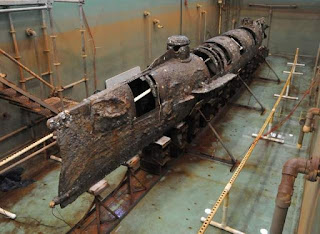C.S.S. Hunley
Since the
discovery of the C.S.S. Hunley, a sunken
Confederate submarine near Charleston Harbor, a growing body of research is
emerging on the Confederacy’s secret weapons.
Many of these weapons were designed by a surprising array of Southern
professional men; those with a knack for finance, military engineering and
subterfuge. One of the most prominent
was an unlikely Texas resident that few would know about until decades later.
Prior to the
Civil War, Ohio native Edgar C. Singer was a gunsmith in the tiny port village
of Lavaca just off the Texas coast. He
came from a family of noted inventors. Singer’s
uncle, Isaac Merritt Singer, invented the first commercially successful sewing
machine. After Texas seceded, Singer
enlisted in the Confederate Army and was assigned to a coastal battery.
With many
young Texans being shipped off to eastern battlefields, the defense of the
Texas coast rested upon older, middle-aged men.
Captain Daniel Shea’s artillery company, which included Singer, was
positioned to help defend the Matagorda Bay area. Among its company roster were professional, middle-aged
men from Lavaca: jewelers, gunsmiths, merchants, doctors, attorneys,
carpenters, and steam engineers. Despite
their diverse backgrounds, they had one common affiliation - the local Masonic
lodge.
Shea’s
company received their baptism of fire when a Union fleet sailed into Matagorda
Bay and shelled Lavaca. Seeing their
homes bombarded led to a sustained outrage that would bring fear and grief to
the Union Navy; they were determined to prevent another bombardment.
Shortly
after the Union fleet departed, Singer began experimenting with underwater torpedoes
or mines as they are called today. The experiments
proved successful, but required men and government support to deploy them on a massive
scale. In addition, the use of hidden
explosives was considered a dishonorable form of warfare, more of a criminal
act than an act of war. Nevertheless,
the Confederacy possessed little in the way of a standing navy and had to rely
on unorthodox methods to defend her coasts and rivers. For much less than the cost of a trained crew
and a steam-powered warship, a small torpedo could fit the bill quite nicely.
Singer’s new
mine was successfully tested on a half submerged wreck before Captain
Shea. Impressed by the result, Singer
was ordered to present his creation to the Texas district commander, Major
General John Magruder.
Based in
Houston, Magruder, or “Prince John” as he was referred to by friends, was no
stranger to the use of unorthodox military tactics and weapons. During the 1862 Peninsula Campaign, his use
of such tactics helped stall the Union advance on Richmond. When Singer blew up an old scow in Buffalo
Bayou, an excited Magruder ordered torpedoes for the defense of Galveston and
Matagorda.
Small in
size, but awesome in delivery, the Singer torpedo was a metal canister filled
with gunpowder and topped with a spring-loaded rod, somewhat similar in
appearance to a butter churn. Anchored 3
feet below the water’s surface, the torpedo was set off when a vessel’s hull struck
the rod. Like a pinball machine, the rod
slammed into 2 percussion caps that set off the gunpowder. In a terrifying flash, a heavily armed warship
could be sent straight to the bottom.
In early
February 1863, Singer travelled to Richmond to demonstrate his invention. After convincing the Confederate government
of the torpedo’s potential, he was awarded a patent and authorization to form a
company of twenty five men. Christened
“Singer’s Submarine Corps.,” most of the company consisted of Singer’s fellow
masons. From his Lavaca workshop,
Singer began cranking out his deadly devices while his company fanned out
across the Confederacy to deploy them.
On the Yazoo River in Mississippi, they hit pay dirt; a Union ironclad, U.S.S. Baron De Kalb, struck two Singer
mines and sank.
Singer’s company
wasn’t limited to torpedoes; they supervised and assisted in the construction
of submarines and torpedo boats. At the
port of Mobile, Singer met three New Orleans inventors: James McClintock,
George Baxter and Horace Hunley. The
three had experimented with submarines in New Orleans until Union forces
captured their city. Plans for a new
submarine were drawn up to be used against Union blockading vessels off the gulf
coast. Singer offered to put up a third
of the $15,000 construction cost. Named
after Horace Hunley, the submarine was armed with a spar torpedo activated by
Singer’s patented, spring-loaded trigger.
On the night of February 17, 1864, the C.S.S. Hunley sank the Union gunboat U.S.S.Housatonic, the first vessel in history to be sunk by a
submarine. The Hunley, however, failed to make the return trip and was lost along
with its crew.
Captured
documents in Mississippi revealed his torpedo operations to Admiral Porter, the
commander of the Mississippi River Fleet.
Having lost two ironclads to torpedoes, Porter ordered Singer and his
company to be “shot on sight.” That
didn’t deter Singer, whose Lavaca-made torpedoes sank another one of his
ironclads, the U.S.S. Eastport on the
Red River.
Though
twenty-seven Union ships were sunk by torpedoes, Singer’s creations couldn’t fully
deter Union Navy. His company spent
their final days mining the James River near Richmond and the Texas coast. To avoid prosecution for war crimes, most of
the Singer documents were destroyed by its members. After Texas was surrendered, Singer and his
fellow Masons signed parole papers and retired to obscurity in Lavaca (now Port
Lavaca). Most of their activities are
lost to history but certainly not their impact.






